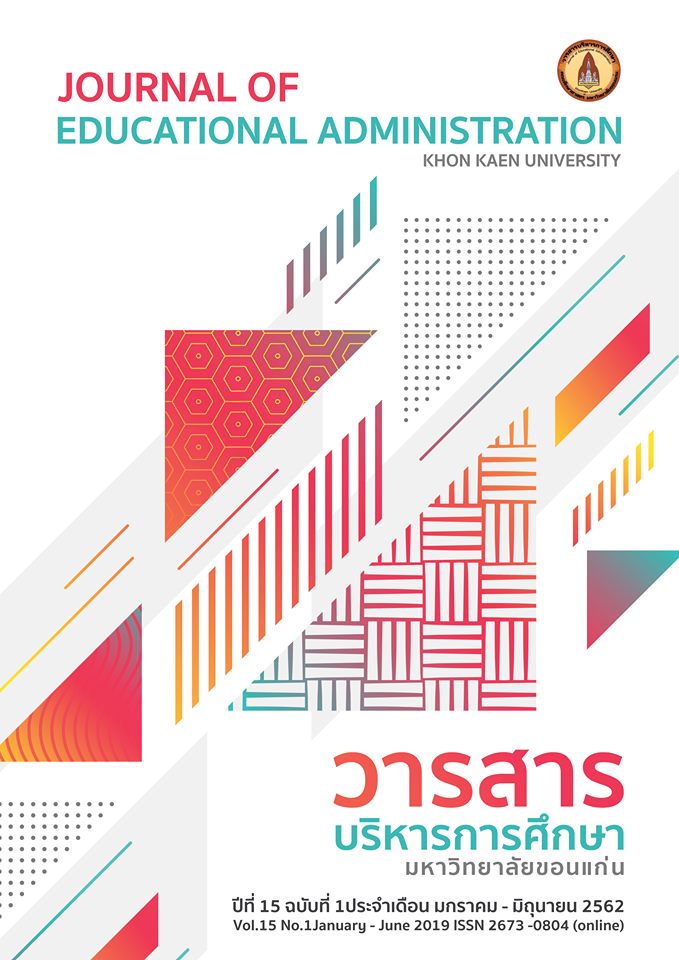การพัฒนารูปแบบการบริหารเพื่อสร้างนวัตกรรมการจัดการเรียนรู้ในโรงเรียนมัธยมศึกษา สังกัดสำนักงานคณะกรรมการการศึกษาขั้นพื้นฐาน
Main Article Content
Abstract
The purpose of this research were to 1) study the components of administration model for creating learning management innovations in Secondary schools under The Office of the Basic Education Commission 2) study current conditions, desirable condition and the need for administration for creating learning management innovations in Secondary schools under The Office of the Basic Education Commission 3) The development an administration model for creating learning management innovations in Secondary schools under The Office of the Basic Education Commission and 4) study the results of using the administration model for creating learning management innovations in Secondary schools under The Office of the Basic Education Commission. Research and Development were administered in this research. Conduct research in 3 phases as follows: Phase 1 (R1) study the components and current conditions, desirable conditions and the need for administration model for creating learning management innovations in Secondary schools, Phase 2(D1) The development of an administration model for creating learning management innovations in Secondary schools and Phase 3 (R2D2) study the results of using The development an administration model for creating learning management innovations in Secondary schools. The sample group used to collect qualitative data consisted of experts, school administrators and teachers in innovative schools. School administrators and teachers in schools that use the format. The sample group used to collect quantitative data consisted of school administrators and teachers in secondary schools under the Office of the Basic Education Commission in the academic year 2018, the number of 560 persons. The confidence of the questionnaire is 0.976. The research instruments consisted of interview form, questionnaire and evaluation form.
Research findings were as follows: The components of administration model for creating learning management innovations in Secondary schools under The Office of the Basic Education Commission has 5 components as follows: 1) Creative Culture 2) Innovative Leadership 3) Strategic Planning for Innovations 4) Innovation Process and 5) Innovation Measurement in School. The current conditions, desirable conditions and need for administration models for creating learning management innovations in secondary schools under the Office of the Basic Education Commission, it was found that the overall current condition at a moderate level and overall desirable condition at the highest level. The highest need for the index was the Innovation Process, followed by the Innovation Measurement in School and the Creative Culture and Innovative Leadership, Respectively. The areas with the lowest need are the Strategic Planning for Innovations. The result of model development and evaluation of administration models for creating learning management innovations in secondary schools under the Office of the Basic Education Commission found that the model created and developed is called CL-2PM MODEL. It consists of 5 important elements: 1) Creative Culture 2) Innovative Leadership 3) Strategic Planning for Innovations 4) Innovation Process and 5) Innovation Measurement in School and the results of the model examination by experts found that the form is accuracy, Propriety, feasibility, and Utility at the highest level in all aspects. The result of using the model found that teachers created learning management innovations according to the goals set by the school. The learning management innovations that is built in good quality. The person involved in the implementation of the model has the highest level of satisfaction, and the quality of the model has the standard of accuracy, propriety, feasibility, and utility at the highest level as well.
Article Details
References
ณิชา ฉิมทองดี. (2557). กลยุทธ์การบริหารโรงเรียนเพื่อสร้างนวัตกรรมการจัดการเรียนรู้. วิทยานิพนธ์ปริญญาครุศาสตรดุษฎีบัณฑิต สาขาวิชาการบริหารการศึกษา บัณฑิตวิทยาลัย จุฬาลงกรณ์มหาวิทยาลัย.
ธนกฤต สิทธิราช, ภาณุวัฒน์ ภักดีวงศ์, อนุชา กอนพ่วง, & ฉันทนา จันทร์บรรจง. (2558). อนาคตภาพการจัดการมัธยมศึกษาของประเทศไทยในสองทศวรรษหน้า. วารสารศึกษาศาสตร์ มหาวิทยาลัยนเรศวร, 17(3), 71-81.
ธีระเกียรติ เจริญเศรษฐศิลป์. (2559). การศึกษาไทย 4.0 ในบริบทการจัดการศึกษาเพื่อการพัฒนาที่ยั่งยืน. ใน การวิจัยนวัตกรรมการเรียนรู้และการจัดการศึกษาเพื่อพัฒนาที่ยั่งยืน. การประชุมทางวิชาการของคุรุสภาประจำปี 2559. กรุงเทพฯ: กระทรวงศึกษาธิการ.
เนาวนิตย์ สงคราม. (2556). การสร้างนวัตกรรม: เปลี่ยนผู้เรียนให้เป็นผู้สร้างนวัตกรรม. กรุงเทพฯ: สำนักพิมพ์แห่งจุฬาลงกรณ์มหาวิทยาลัย.
บุญชม ศรีสะอาด. (2547). วิธีการทางสถิติสำหรับการวิจัย (พิมพ์ครั้งที่ 4). กรุงเทพฯ: สุวีริยาสาส์น.
ปราโมทย์ พรหมขันธ์. (2556). การพัฒนาความสามารถของครูด้านการออกแบบและสร้างนวัตกรรมการศึกษาโดยใช้วิจัยเป็นฐาน. วารสารครุศาสตร์ มหาวิทยาลัยราชภัฎลำปาง, 41(3), 98-114.
พรชัย เจดามาน และคณะ. (2559). ยุทธศาสตร์การพัฒนาเพื่อการบริหารจัดการสู่การเปลี่ยนผ่านศตวรรษที่ 21: ไทยแลนด์ 4.0. วารสารหลักสูตรและการเรียนการสอน คณะคุรุศาสตร์ มหาวิทยาลัยราชภัฏมหาสารคาม, 2(1), 1-14.
ไพฑูรย์ สินลารัตน์. (2559). การศึกษา 4.0 เป็นยิ่งกว่าการศึกษา. กรุงเทพฯ: โรงพิมพ์แห่งจุฬาลงกรณ์มหาวิทยาลัย.
ไพฑูรย์ สินลารัตน์ และคณะ. (2554). สัตตสิกขาทัศน์ เจ็ดมุมมองการศึกษาใหม่และการเรียนการสอนนอกกรอบ 7 ประการ. กรุงเทพฯ: มหาวิทยาลัยธุรกิจบัณฑิต.
รมิดา ถิรปาลวัฒน์. (2557). ความเป็นองค์กรนวัตกรรมและความสามารถทางนวัตกรรมของพยาบาลวิชาชีพ. วารสารวิทยาลัยพยาบาลกองทัพเรือ, 13(2), 13-17.
วชิน อ่อนอ้าย, ฉันทนา จันทร์บรรจง, วิทยา จันทร์ศิลา, & สำราญ มีแจ้ง. (2558). รูปแบบการพัฒนาโรงเรียนเอกชน สู่ความเป็นองค์การแห่งนวัตกรรม. วารสารศึกษาศาสตร์ มหาวิทยาลัยนเรศวร, 17(2), 74-84.
วิจารณ์ พานิช. (2555). วิถีสร้างการเรียนรู้เพื่อศิษย์ในศตวรรษที่ 21. กรุงเทพฯ: มูลนิธิสดศรี-สฤษดิ์วงศ์.
ศรีน้อย ลาวัง. (2552). การวิเคราะห์กระบวนการพัฒนานวัตกรรมการเรียนการสอนของครูโดย
ใช้เทคนิคการสืบสอบแบบชื่นชม. วิทยานิพนธ์ปริญญาครุศาสตรมหาบัณฑิต สาขาวิชาวิจัยการศึกษา บัณฑิตวิทยาลัย จุฬาลงกรณ์มหาวิทยาลัย.
สุกัญญา แช่มช้อย. (2555). แนวคิดเชิงนวัตกรรมสำหรับการบริหารสถานศึกษาในศตวรรษที่ 21. วารสารศึกษาศาสตร์ มหาวิทยาลัยนเรศวร, 14(2), 117-128.
สุคนธ์ สินธพานนท์. (2551). นวัตกรรมการเรียนการสอนเพื่อพัฒนาคุณภาพของเยาวชน (พิมพ์ครั้งที่ 2). กรุงเทพฯ: โรงพิมพ์ 9119 เทนนิคพริ้นติ้ง.
สุวิมล ว่องวานิช. (2558). การวิจัยประเมินความต้องการจำเป็น (พิมพ์ครั้งที่ 3 ฉบับปรับปรุง). กรุงเทพฯ: สำนักพิมพ์แห่งจุฬาลงกรณ์มหาวิทยาลัย.
สำนักงานส่งเสริมสังคมแห่งการเรียนรู้และพัฒนาคุณภาพเยาวชน. (2558). เปิดทิศทางการจัดการศึกษาโลก 15 ปีข้างหน้า ปักธงพัฒนาคุณภาพ-การเรียนรู้ตลอดชีวิต-การเข้าถึงกลุ่มเด็กด้อยโอกาส. ค้นเมื่อ 20 มกราคม 2559, จาก http://www.qlf.or.th/Mobile/Details?contentId=1070
Chen, S., Hsiao, H., Chang, J., Shen, C., & Chou, C. (2013). School organizational innovative indicators for technical universities and institutes. Contemporary Issues in education research, 3(7), 43-50.
Haelermans, C., & DeWitte, K. (2011). The role of innovations in secondary school performance: Evidence from a conditional efficiency model. European Journal of Operational Research, 223(2), 541-549.
McMillan, J. H., & Schumacher, S. (2001). Research in Education. A Conceptual Introduction (5th ed.). New York: Longman.
Smith, M. (2010). Factors influencing an organization’s ability to manage innovation: A structured literature review and conceptual model. International Journal of Innovation Management, 12(4), 1-22.
Von Stamm, B. (2008). Managing innovation, design and creativity (2nd ed.). Chichester, UK: John Wiley & Sons.
Yamane, T. (1967). Statistics, An Introductory Analysis (2nd ed.). New York: Harper and Row.


